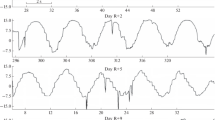Abstract
Pre-and postflight examinations of cosmonauts participating in missions ISS-3 to ISS-9 on the International Space Station were performed using a computer-aided method of integrated assessment of the oculomotor system. The role and significance of the vestibular system in the eye tracking were determined; the individual and general characteristics of spontaneous oculomotor reactions and oculomotor reactions induced by visual and vestibular stimuli after a long-term stay at zero gravity (126–195 days) were determined; and the changes in the indices of oculomotor reactions were monitored. Studies of the vestibular function, intersensory interactions, and the tracking function of the eyes in the crew members were performed on the second, fifth (sixth), and ninth (tenth) days of the readaptation period. The results of the postflight examinations showed a significant change in the accuracy, velocity, and temporal characteristics of eye tracking and an increase in the vestibular reactivity. It was shown that the structure of visual tracking (the accuracy of fixational eye rotations and smooth tracking) was disturbed (the appearance of correcting saccades, the transition of smooth tracking to saccadic tracking) only in those cosmonauts who, in parallel to an increased reactivity of the vestibular input, also had central changes in the oculomotor system (spontaneous nystagmus, gaze nystagmus). With one exception, recovery of the indices of the accuracy of tracking eye movements in cosmonauts to the background level in the selected period of examination was not observed, although a positive trend was recorded.
Similar content being viewed by others
References
Mit’kin, A.A., Modern Problems of the Visual-Vestibular Interaction, Usp. Fiziol. Nauk, 1982, vol. 13, no. 3, p. 56.
Raines, V.S., Neurophysiological Mechansms of the Interaction of the Vestibular System with Other Sensory Systems, Kosm. Biol. Aviokosm. Med., 1974, vol. 8, no. 5, p. 3.
Buttner, U. and Buttner-Ennever, J., Present Concepts of Oculomotor Organization, in Neuroanatomy of the Oculomotor System, Buttner-Ennever, J., Ed., New York: Elsevier, 1988, pp. 3–23, 119–176.
Hofstetter-Degen, K., Wetzig, J. and Baumgarten, R., Oculovestibular Interaction under Microgravity, Clinik Investigator., 1993, vol. 71, p. 749.
Leigh, R. and Zee, D.S., The Neurology of Eye Movements, New York: Oxford University Press, 1999, pp. 90–186, 407–478, 550.
Kornilova, L.N., Bodo, G., Grgorova, V., and Chernobyl’skii, L.M., Neurophysiological Regularities of Adaptation of the Vestibular System to Conditions of Microgravity, Aviokosm. Ekol. Med., 1993, vol. 3, no. 3, p. 219.
Kornilova, L.N., Grigorova V., and Bodo, G., Vestibular Function and Sensory Interaction in Space Flight, Vestib. Res., 1993, vol. 3, no. 3, p. 219.
Kornilova, L.N., Vestibular Function and Sensory Interaction under the Condition of Altered Gravity, Adv. Space Biol. Med., 1997, vol. 6, no. 12, p. 257.
Kornilova, L.N., Muller, H., West, G., et al., Spontaneous and Visually-Induced Oculomotor Reactions at Zero Gravity (According to the Data of the Optovert Experiment), Aviokosm. Ekol. Med., 1996, vol. 30, no. 6, p. 30.
Kornilova, L.N., The Tracking Eye Function under Microgravity and Readaptation to Earth’s Gravitation, Aviokosm. Ekol. Med., 2001, vol. 35, no. 6, p. 30.
Reschke, M., Kozlovskaya, I.B., Somers, J., et al., Smooth Pursuit Deficits in Space Flights of Variable Length, J. Gravitat. Physiol., 2002, vol. 9, no. 1, p. 133.
Kornilova, L.N., Solov’eva, A.D., Sarantseva, A.V., et al., Computer Tests to Study Oculomotor Reactions in Patients Complaining of Dizziness, Zh. Nevrol. Psikhiatr. im. S.S. Korsakova, 2004, no. 5, p. 34.
Kornilova, L.N., Yakovleva, I.Ya, and Bodo, G., Patent 1454374, 1994.
Dix, M. and Hood, J., Vertigo, Chichester: John Wiley and Sons, 1987.
No, de L., Vestibulo-Ocular Reflex Arc, Arch. Neurol., 1933, vol. 30, no. 2, p. 245.
Ulrich, H., Die Function der Otolithen, gepruft durch directe mechanische beeinflussung der Utriculusototolithen am lebenden Hecht, Pflugers Arch., 1935, Vol. 235, no. 4, pp. 545–553.
Szentagothai, J., A Midbrain Inhibitory Mechanisms of Oculomotor Activity, Acta Physiol. Acad. Sci. Hung., 1956, vol. 9, nos. 1–3, p. 89.
Author information
Authors and Affiliations
Additional information
Original Russian Text © L.N. Kornilova, M.I. Alekhina, V.V. Temnikova, M. Reshke, S.V. Sagalovich, S.V. Malakhov, I.A. Naumov, I.B. Kozlovskaya, A.V. Vasin, 2006, published in Fiziologiya Cheloveka, 2006, Vol. 32, No. 5, pp. 56–64.
Rights and permissions
About this article
Cite this article
Kornilova, L.N., Alekhina, M.I., Temnikova, V.V. et al. The effect of a long stay under microgravity on the vestibular function and tracking eye movements. Hum Physiol 32, 547–555 (2006). https://doi.org/10.1134/S0362119706050082
Received:
Issue Date:
DOI: https://doi.org/10.1134/S0362119706050082



